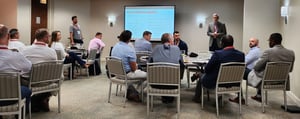Educational Webinars
Below is a series of videos that are available for student teams to download and review to learn more about fluid power as it relates to the Vehicle Challenge program, including the MANDATORY safety video and PowerPoint.
Accumulator Pre-Charge for FPVC (30 minutes)
Determining the Accumulator Pre-Charge for the Fluid Power Vehicle Challenge Competition webinar led by Ernie Parker. Download Ernie Parker's PowerPoint.
Objectives:
- Understand metric and standard equations to determine optimal charge
- Understand how to use gauges with different types of accumulators
Fluid Power Safety PowerPoint
Fluid power safety is of the utmost importance. All program participants are required to review this presentation on fluid power safety.
Objectives:
- Personal Safety
- Lab Safety
- Equipment Safety
- Chemical Safety
- Design Safety
Fluid Power Safety (33 minutes)
Fluid power safety is of the utmost importance. All program participants are required to review this presentation on fluid power safety.
NOTICE: This video contains graphic images of actual injection injuries and what was required to properly treat them to underline the importance of safety.
Objectives:
- Dangers of suddenly released stored energy
- How to keep people out of harm's way
- Dangers of high-pressure fluid injection and what to do if that happens
- Creating a culture that recognizes and protects again fluid power injuries
Mounts & Case Drains Webinar (25 minutes)
Refer to the Lightening Reference Handbook
Objectives:
- Identify different pump mounts
- Understand when to use case drains
Sizing Components (60 minutes)
Objectives:
- Calculate the pull of the vehicle
- Calculate the torque of the drive wheel
- Determine your system pressure (PSI)
- Size the drive motor for cubic inches per revolution (CIR)
- Calculate wheel RPM
- Calculate GPM (gallons per minute)
- Calculate HP (Horsepower)
- Size the hydraulic lines
- Size the pump
Testing Efficiency (25 minutes)
Objectives:
- List of necessary equipment needed for testing
- Schematics and formulas for calculating: Volumetric, Mechanical, and overall efficiency
- Show pictures of setups and testing
Tube Flaring, Bending and Assembly Video (50 minutes)
Objectives:
- Comparison of tubing and hoses
- Necessary equipment
- Flaring Procedures
- Tube Bending
- Relevant Calculation
GPM Controls, Understanding Schematics (60 minutes)
Dan Turner of GPM Controls offers this explanation of how to understand schematics.
Objectives:
- Learn how a fluid power system can be represented by a schematic and its symbols
- Learn how to read a schematic and follow the flow path of the fluid
- Discuss why a schematic is helpful for troubleshooting and design
How and Why to Get Certified in Fluid Power Video (30 minutes)
Objectives:
- Background of the International Fluid Power Society (IFPS)
- Hydraulic Specialist Certification
- Pneumatic Specialist Certification
- Master Certification Pathways
- How certifications enhance your career
- How to Get Certified
- The Cost of Certification
IFP Motion Solutions, Use of Electronics (30 minutes)
Objectives:
- Why Electronics
- Displays
- Logic and Valve Drivers
- Control “Kits”
- Electro-Hydraulic Valves
- Pressure Reducing Application
Introduction to Fluid Power Systems (45 minutes)
Objectives:
- Define fluid power systems
- Compare hydraulic and pneumatic systems
- Basic fluid power devices and their associated schematics
- Identify critical fluid power properties, pressure, flow rate, and valve position
- Discuss how these properties must be controlled and measured by a fluid power system to control the strength, speed, and direction of resultant mechanical output.
Fundamentals of Fluid Power Course (6 Week Module)
Objectives:
- Benefits and limitations of fluid power compared with other power transmission technologies
- Operation, use and symbols of common hydraulic components
- How to formulate and analyze models of hydraulic components and circuits
- How to design and predict the performance of fluid power circuits
Introduction to Schematics (1 hour)
Introduction to Schematics and Symbology video with Ernie Parker. Download Ernie's Webinar Slides.
Objectives:
- Understand symbols used in schematics
- Understand how to create a schematic for the Fluid Power Vehicle Challenge
GPM Controls, Overview of Fluid Power (40 minutes)
Dan Turner, president of GPM, provides this overview of fluid power.
Objectives:
- Why use hydraulics as a power source
- Where hydraulics is used
- Basic principles of fluid power
- Real-world application of math & physics
- Basic flow dynamics
GPM Controls, Choosing Cylinders and Pumps (1 hour)
Objectives:
- Identify a variety of cylinders and pumps
- Learn the features of different cylinders and pumps
- Discuss how to select the right cylinder or pump for your application
GPM Controls, Components of a Hydraulic System (45 minutes)
Objectives:
- Identify the major components commonly found in hydraulic systems
- Learn about the selection properties of cylinders
- Discuss types of pumps
- Learn about types of valves and reservoirs
- Discuss types of accumulators and their applications
GPM Controls, Presentation on Accumulators (55 minutes)
Download GPM Accumulators Webinar PowerPoint
Objectives:
- Accumulator description
- 3 types of accumulators
- Applications for accumulators
- Safety tips
IFPS Webinar with Ernie Parker: How to Size an Accumulator (40 minutes)
Download IFPS Accumulator Sizing Webinar PowerPoint Slides
Objectives:
- Basic calculations for pressure and volume when using all of the oil
- Basic calculations when using part of the accumulator volume
- Sizing an accumulator for a change in temperature
- Sizing an accumulator with an isothermal condition
- Sizing an accumulator with an adiabatic condition
- Setting a pre-charge pressure
- Charging accumulator
For more webinars like this one, please consider joining the International Fluid Power Society.
IMI, Use of Pneumatics & Applications (32 minutes)
Objectives:
- Review of Competition Rules
- Why Pneumatics
- Suggested applications to Consider
- Suggested products you will need
- Safety
- Circuits and products

